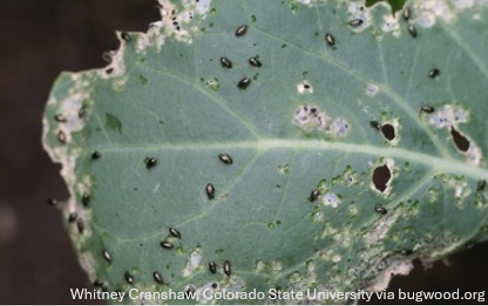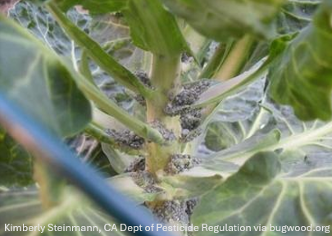Getting a head start on next year’s pests
Do you want to get a head start on managing next year’s insect pests? Focus on managing your crop residue. Removing or tilling in crop residue this fall could make a big impact towards pest management. Read below for pest specific strategies on residue management as well as other cultural control options.
Root Maggots
Onion Maggot
Adults emerge in mid-May. A good indicator of the start of root maggot flight is blooming of the common roadside weed yellow rocket. Once damage has been detected, it is too late to control this pest. Therefore, prevention is key, and if any plants were infected this season control begins this fall.

- Residue and cull pile management: Onion maggot pupae can overwinter in crop residue and cull piles, so it is important to remove residue and infected onions from the field as quickly as possible. Cull piles should either be buried or incorporated deep into a compost pile to limit plant material accessible to the adult flies to feed and lay eggs.
- Light fall tillage: In addition to residue, the pupae also overwinter in the top 1-2″ of soil. A light tillage in the early fall can bring the pupae to the surface where they are exposed to predators and are potentially less likely to survive the cold.
- Timing of planting: Planting onion sets one week before flies are expected to emerge can reduce damage. Timing of yellow rocket bloom can cue you in, but the Vegetable Disease and Insect Forecasting Network can provide more specific data for your area.
- Crop rotation: If possible, plant onions at least ½ mile away from where the previous onion crop was planted.
Cabbage Maggot
Cabbage maggots overwinter as pupae in the soil. Early season transplants and spring root crops are often the most negatively affected. The damage caused by cabbage maggots includes not only the direct damage from feeding, but also indirect damage as the feeding creates entry points for other pathogens such as black rot.

- Light fall tillage: The pupae overwinter in the top 1-2″ of soil. A shallow tillage in the early fall can expose the pupae to predators such as birds and rodents and expose them to harsh weather conditions which can reduce their survival rate.
- Residue management: Destroying crop residue including roots will help to reduce overwintering sites and thus decrease the population going into the next season.
- Timing of Planting: Delay planting until after first flight is done. This is usually mid-May, but it can vary depending on the accumulation of growing degree days. Please reference the Vegetable Disease and Insect Disease Forecasting Network for specific details for your location.
- Crop rotation: If possible, do not plant spring brassicas in the same fields that had fall brassicas this year. The greater the distance between next year’s brassica fields and this year’s brassica fields the better.
More information can be found here.
Cucurbit Pests
Squash Bugs

Squash bugs have been a problem for Wisconsin growers in recent years. It’s difficult to spray for squash bugs; they congregate on the underside of leaves, and their long egg-laying period means they may be present as eggs, nymphs, and adults at the same time. To manage squash bugs:
- Remove or Till Crop Residue: Removing the overwintering sites of unmated squash bug adults will reduce the overall population.
- Reduce Early-Season Populations: Squash bugs are most destructive to young plants, and sprays are more effective on nymphs than adults.
More information can be found here.
Brassica Pests
Crucifer Flea Beetles

Crucifer flea beetles emerge in early to mid-spring and can greatly reduce the quality of cruciferous crops harvested for their leaves by creating a ‘shothole’ appearance. Control measures for flea beetles include:
- Remove crop residue: Flea beetles feed on crop residue leading to an increased population size that overwinters both in the crop residue and nearby vegetation. They can be particularly damaging early in the season so taking steps this fall to reduce their population can go a long way
- Control of alternative host species: In addition to crop residue, flea beetles overwinter on alternative hosts including brassica weeds such as wild mustard, perennial pepperweed, dame’s rocket, field pennycress and shepherd’s purse.
More information can be found here.
Cabbage Aphids

There are multiple generations per summer and because their populations can explode quickly during cooler fall weather, it is important to try to prevent large populations from over wintering. Ways to manage cabbage aphids include:
- Removal of crop residue in fall or early spring: Cabbage aphids overwinter as eggs on crop residue and the underside of brassica weeds. Residue should either be removed or tilled in the fall to eliminate overwintering sites. If it is not possible to remove residue in the fall, residue can removed in early spring before eggs have the chance to hatch
- Control of alternative hosts: Similar to flea beetles, cabbage aphids can also overwinter on a variety of weeds in the brassica family. Please see a list of alternative hosts under flea beetles
More information can be found here.
Imported Cabbage Worm
Imported cabbage worm overwinter as green chrysalae on plant debris, and adults start emerging and laying eggs in early May. They produce between three and six generations per year making them an important pest of brassicas.

- Removal of crop residue: While the second generation often causes the most damage, controlling the population size going into the season can help reduce the level of damage.
- Control of alternative hosts: Brassica weeds and cover crops can also serve as overwintering sites. Please see the list of alternative hosts under flea beetles.
More information can be found here.
Diamondback Moth
Cultural control measures are particularly important for diamondback moths. While there are several organic insecticide options currently available, diamondback moths in other areas of the United States are developing resistance to Bt.

- Removal of crop residue and related weeds: They overwinter as adults on crop debris and weeds allowing them to be early season pests. Residue removal and weed control will help keep population levels down.
More information can be found here.
Swede Midge
Once swede midge is present in an area, it can be very difficult to manage without the use of systemic insecticides. Compounding the difficulty of control is the fact that larva feed concealed within the growing point of a plant. Therefore, the best control is prevention.

- Removal or tillage of crop residue: Swede midge can keep feeding and reproducing on residue from harvested crops into the fall. The sooner the residue is removed or broken down, the greater the potential population control.
- Control and removal of alternative hosts in the spring: Adults usually emerge from mid-May to mid-June. Mating occurs shortly after emergence, and then females begin looking for a suitable host on which to lay their eggs. Adults only live one to five days and therefore have a short window to find a suitable host. Hosts include crop residue, brassica cover crops, and brassica weeds such as shepherd’s purse and wild mustard.
More information can be found here.
Asparagus Pests
Common Asparagus Beetle

There are two types of asparagus beetles in WI-common and spotted. The common asparagus beetle is the most prevalent and can cause significant damage to the ferns unlike the spotted which only feeds on berries. Damage to the ferns in spring can lead to a drop in crop quality due to browning and bent stems while feeding in the summer can lead to reduced yield in subsequent seasons. Management options include:
- Finely chop, remove or burn ferns: Once ferns have turned completely brown at the end of season, it is important to eliminate this potential overwintering site for adult beetles. Ideally, residue will be removed and composted off site, but if that is not possible residue should be chopped into very small pieces so it breaks down quickly. If necessary, residue management can occur in the spring but should be done as early in the season as possible.
- Harvest frequency: harvest all ferns every 3 to 5 days to reduce habitat for eggs and feeding larva to keep populations levels down
Resources
- A3719-E: Cabbage Maggot
- A3711: Onion Maggot
- Aphids (wisc.edu)
- Aphid, Cabbage (umass.edu)
- Asparagus Beetle (wisc.edu)
- Cabbage and onion maggots (umn.edu)
- Cabbage Maggot (wisc.edu)
- Caterpillars on Cole Crops (umn.edu)
- Caterpillar Pests of Cole Crops (wisc.edu)
- Common asparagus beetle (umass.edu)
- Cultural Control (wisc.edu)
- Flea Beetles (umn.edu)
- Flea Beetles (wisc.edu)
- Hallett, 2007
- Hodgon et al, 2024
- Onion Maggot (wisc.edu)
- Stratton et al, 2018
- Squash Bug (wisc.edu)
- Squash Bugs in Home Gardens (umn.edu)
- Swede Midge (umn.edu)
- Swede Midge Information Center (cornell.edu)
Reviewed by: Russ Groves, Kristin Krokowski, and Ari Abbrescia
Updated: Nov. 25, 2024

 ▶ Robotics and Automation for Weed Management
▶ Robotics and Automation for Weed Management Cut-and-Carry Mulch Case Studies
Cut-and-Carry Mulch Case Studies 2025 Commercial Vegetable Production in Wisconsin (A3422)
2025 Commercial Vegetable Production in Wisconsin (A3422)


